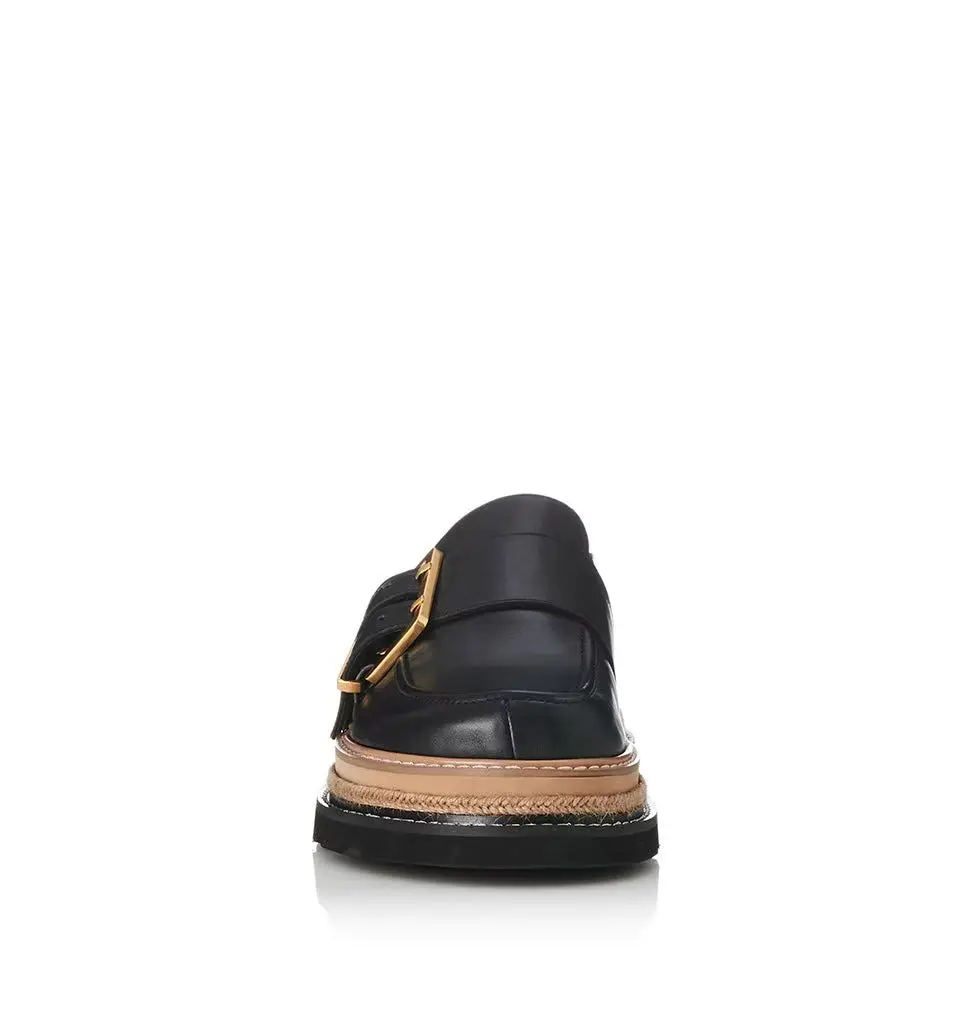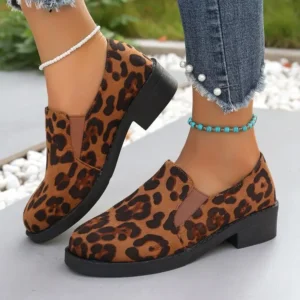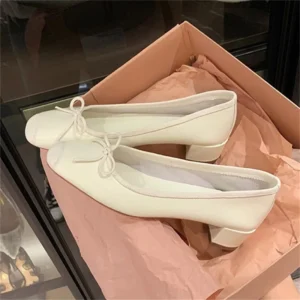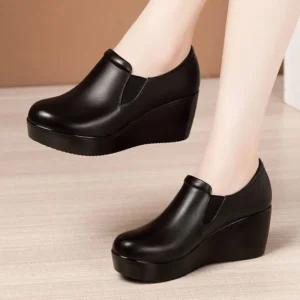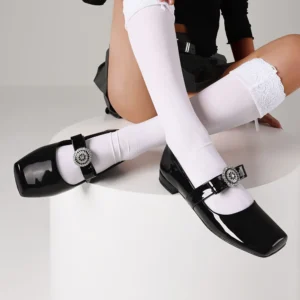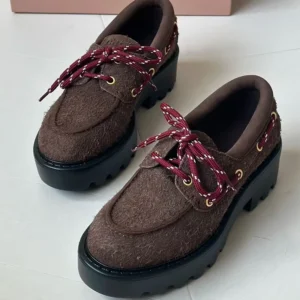Understanding Wedge Heel Loafers and Your Foot Health
Wedge heel loafers represent a unique hybrid in the footwear world, combining the continuous elevated sole of a wedge with the classic slip-on design and often decorative upper of traditional loafers. Unlike conventional heels that create a distinct break between the heel and forefoot, wedge loafers feature a solid piece extending from heel to toe, creating a seamless incline. This design offers a distinctive look while promising greater stability and more even weight distribution than stiletto or block heels.
Many women turn to wedge loafers seeking a comfortable alternative to traditional high heels. The continuous sole creates a larger surface area contacting the ground, potentially increasing stability and reducing the feeling of walking on stilts that often accompanies narrow heels. However, the relationship between wedge loafers and foot health is more complex than simply being “better than high heels.”
The history of wedge heels actually begins with orthopedic intentions. In the 1930s, Italian designer Salvatore Ferragamo created the first modern wedge heel during a period of material shortages, using cork to create a supportive, stable alternative to traditional heels. This orthopedic origin hints at potential benefits, yet today’s fashion-forward versions may prioritize aesthetics over the original therapeutic design.
As consumers increasingly demand footwear that combines style with genuine comfort, understanding the true impact of wedge loafers on foot health becomes essential. In this article, we’ll explore the biomechanics of wedge loafers, break down their structural components, analyze their impact on common foot conditions, and provide practical guidance for selecting and wearing options that truly support foot health. The ideal approach balances the professional office loafer outfits you desire with the biomechanical support your feet need.
The Biomechanics: How Wedge Loafers Affect Your Feet
When you step into a pair of wedge heel loafers, you’re altering your body’s natural biomechanics in several important ways. Understanding these changes helps explain both the comfort advantages and potential drawbacks of this popular footwear style.
Weight Distribution Changes
Any elevated heel shifts your body weight forward, increasing pressure on the ball of your foot (metatarsal area). In a wedge loafer with a 2-inch heel, the forefoot experiences approximately twice the normal pressure it would in flat shoes. However, compared to stilettos of the same height, wedges distribute this pressure across a wider area, potentially reducing discomfort.
Postural Adaptations
Your body makes several adjustments to accommodate the forward-tilted foot position:
– Ankles slightly flex forward
– Knees may lock back to maintain balance
– Pelvis might tilt forward
– Lower back curve (lordosis) often increases
– Upper back and neck position adjust to maintain eye level
These changes aren’t necessarily harmful for occasional wear, but persistent postural adjustments can contribute to muscle imbalances over time. The comparative impact is significantly less than with traditional high heels but more pronounced than with flats.
Gait Alterations
Wedge loafers typically cause:
– Shorter stride length
– Reduced natural foot roll from heel to toe
– Decreased ankle movement range
– Modified knee and hip mechanics during walking
The continuous sole of a wedge provides more stability than a traditional heel, allowing for a more natural gait than stilettos. However, the elevated heel and often rigid construction still restrict the foot’s natural flexibility and movement patterns compared to loafers vs heels professional footwear options with flatter profiles.
The biomechanical impact varies significantly with heel height, wedge angle, and individual foot structure. Even modest increases in heel height dramatically increase forefoot pressure, while a gradual wedge angle causes less dramatic postural changes than an abrupt one.
Structural Components of Wedge Heel Loafers
To assess how wedge loafers might affect your foot health, it’s essential to understand the key structural elements and their individual impacts:
Heel Height and Pitch
The vertical rise from ground to heel determines pressure distribution and postural changes. Optimal range for daily wear is 1-2 inches (2.5-5 cm), as this modest elevation provides style without excessive forefoot pressure. Heights above 2.5 inches (6.5 cm) significantly increase strain on the forefoot and may require additional support features to remain comfortable.
Platform Component
Many wedge loafers include a platform section under the forefoot that reduces the effective incline of the foot. For example, a 3-inch heel with a 1-inch platform creates only a 2-inch difference in height between heel and toe. This reduces the actual foot angle and can improve comfort considerably.
Wedge Material
The composition of the wedge itself affects weight, shock absorption, and stability:
– Cork: Lightweight, offers natural cushioning, molds to the foot over time
– Wood: Provides structure but tends to be heavy with minimal shock absorption
– Rubber: Good shock absorption, moderate weight, durable
– EVA foam: Extremely lightweight, excellent cushioning, may compress over time
– PU (polyurethane): Balances durability with shock absorption
Base Width
A wider base creates a more stable foundation, reducing ankle wobble and improving balance. Quality wedge loafers feature a base that extends slightly beyond the upper for maximum stability.
Footbed Design
The interior contours that directly contact your foot determine comfort and support:
– Cushioning density and placement
– Arch support height and position
– Heel cup depth for stability
– Material breathability and moisture management
Toe Box
The front section of the shoe needs adequate width and height to prevent compression of toes. This component is particularly critical in loafer styles that lack adjustable closures.
Our womens wedge heel loafers collection demonstrates how these structural components can be harmoniously integrated to create footwear that supports foot health while maintaining style appeal.
The Toe Box: Critical for Foot Health
The toe box design in wedge loafers deserves special attention because it significantly impacts comfort and long-term foot health. Unlike lace-up shoes that can be adjusted for width, loafers have a fixed shape that must accommodate your foot precisely.
A proper toe box should mimic the natural shape of your foot, widest at the toes and allowing them to spread naturally when bearing weight. When standing, your toes should have approximately 1/2 inch (1.3 cm) of space beyond your longest toe, and sufficient width to wiggle freely without friction against the sides.
Toe box shapes vary considerably in their foot-friendliness:
– Round toe boxes most closely mimic natural foot shape
– Square toe designs offer good width across the forefoot
– Almond shapes provide a balance of style and space
– Pointed toe boxes compress toes inward, potentially causing problems
When toes are compressed in a narrow toe box, several issues can develop over time:
– Bunions (hallux valgus) from pressure on the big toe joint
– Hammertoes from cramped positioning
– Corns and calluses from friction
– Ingrown toenails from pressure on nail edges
– Nerve compression leading to pain or numbness
The forefoot widening that naturally occurs throughout the day due to gravity and activity must also be accommodated. Quality square toe flat loafers demonstrate how functional toe space can be incorporated into stylish designs without sacrificing aesthetics.
Remember that elevated heels, even wedges, push the foot forward into the toe box during walking, making adequate space even more crucial than in flat shoes.
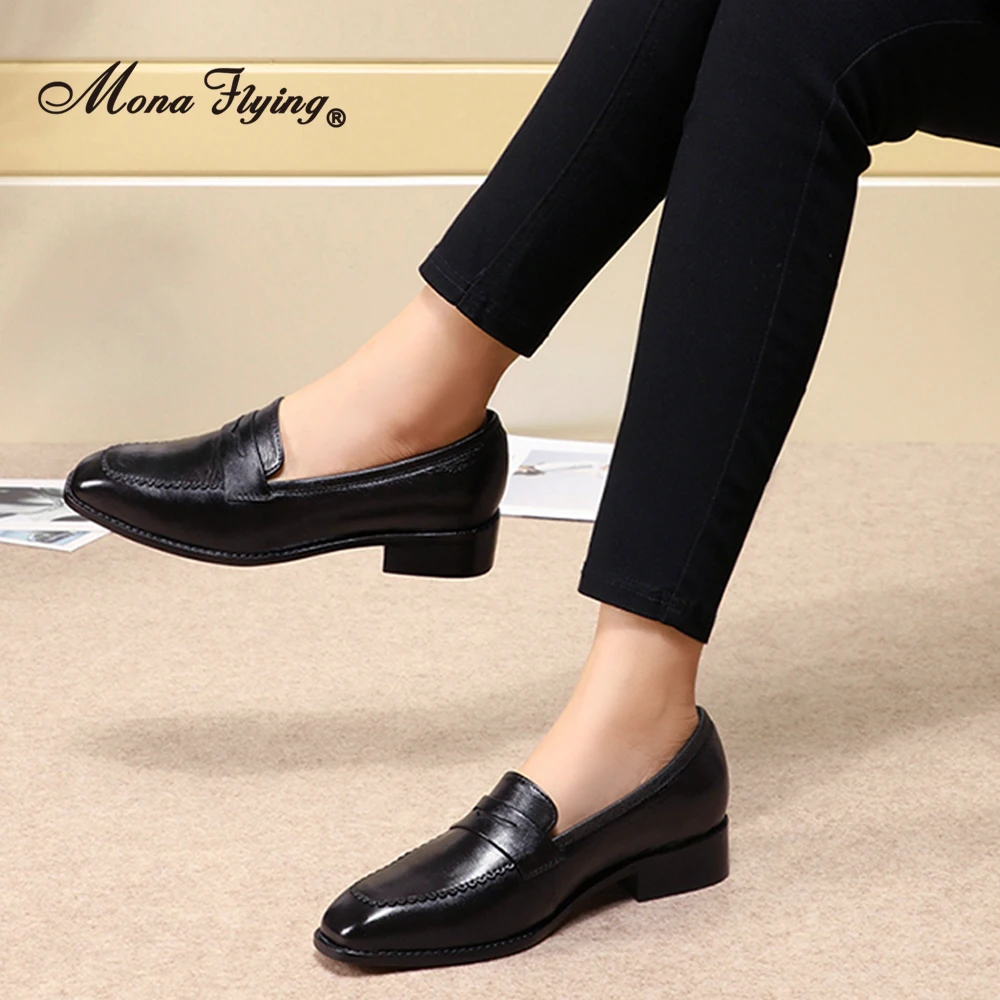
Arch Support and Footbed Design
Proper arch support becomes especially important in elevated footwear like wedge loafers, as the inclined position alters natural foot mechanics and support needs. A well-designed footbed can make the difference between shoes that hurt after an hour and those comfortable enough for all-day wear.
Types of Arch Support in Wedge Loafers
- Contoured arch support: Follows the natural curve of your foot’s arch, providing consistent contact and pressure distribution
- Targeted cushioning: Places softer materials specifically under the arch area
- Removable insoles: Allow customization with orthotics or specialty inserts for personalized support
- Minimal/flat support: Common in fashion-forward designs but offers little actual arch assistance
Key Footbed Features for Comfort
The ideal footbed in wedge loafers combines several elements:
– Deep heel cup that cradles and stabilizes the heel bone (calcaneus)
– Gradual arch contour that matches your natural foot shape
– Metatarsal pad or cushioning under the ball of the foot to relieve pressure
– Breathable materials that manage moisture and heat
– Sufficient cushioning depth to absorb impact without bottoming out
Cushioning Materials and Their Properties
Different materials offer varying benefits in wedge loafer footbeds:
– Memory foam: Molds to foot shape but may compress over time
– Cork: Naturally cushioning, molds gradually, sustainable
– Gel inserts: Excellent for pressure points, maintains shape well
– EVA foam: Lightweight, good initial cushioning, varies in durability
– Latex foam: Responsive bounce-back, moderate durability
– Poron®: Premium material with excellent pressure distribution and durability
For those with specific foot support needs, our ultimate guide supportive wedge loafers provides detailed information about finding options with exceptional arch support and cushioning systems designed for various foot types.
Remember that the best arch support matches your specific foot structure—high arches require different support than flat feet, and one person’s perfect shoe might be uncomfortable for another.
Wedge Height and Angle: Finding the Balance
The height and angle of a wedge heel directly impact foot position, stability, and comfort. Understanding these measurements helps in selecting loafers that offer style without excessive stress on your feet.
Understanding Wedge Measurements
Heel Height: Measured from the ground to the highest point of the heel
– Low wedges: 1-2 inches (2.5-5 cm)
– Medium wedges: 2-3 inches (5-7.5 cm)
– High wedges: 3+ inches (7.5+ cm)
Pitch or Drop: The difference in height between heel and toe
– A 3-inch heel with a 1-inch platform has only a 2-inch pitch
– Lower pitch means less forefoot pressure and more comfort
Optimal Heights for Different Scenarios
For everyday wear and prolonged standing or walking, wedges between 1-2 inches (2.5-5 cm) create the best balance of style and comfort. At this height, forefoot pressure increases moderately but remains manageable for most people.
Medium heights (2-3 inches/5-7.5 cm) work well for normal workdays with moderate walking and occasional sitting breaks, especially when combined with good arch support and cushioning.
High wedges (over 3 inches/7.5 cm) should be reserved for special occasions and limited wear time, as they significantly increase forefoot pressure and alter posture.
Platform Considerations
Front platforms can dramatically improve comfort by reducing the effective angle of the foot. For example:
– A 3-inch wedge without a platform places the foot at approximately a 30-degree angle
– The same wedge with a 1-inch platform reduces the angle to about 20 degrees
– This difference significantly reduces calf muscle strain and forefoot pressure
Our collection of low heel loafers demonstrates how modest heights can create elegant elevation while maintaining comfortable foot positioning for extended wear.
Material Matters: Impact on Support and Comfort
The materials used in wedge loafers significantly affect their weight, flexibility, durability, and support—all factors that directly impact foot health and comfort.
Wedge Core Materials
Cork: A natural material with excellent properties for footwear, cork is lightweight, provides natural cushioning, and molds to your foot over time. It absorbs shock well but can be less durable if not properly sealed.
Lightweight Woods: Materials like balsa or pine create structured wedges that hold their shape well but tend to be heavier and transfer more impact to the foot.
EVA Foam: This synthetic material offers excellent lightweight cushioning but may compress over time, potentially reducing support.
Rubber: Provides good durability and moderate shock absorption but adds weight to the shoe.
PU (Polyurethane): Balances durability with flexibility and cushioning, often used in high-quality wedges.
Upper Materials and Breathability
The materials covering your foot are equally important for comfort:
Leather: Natural breathability allows moisture evaporation, conforms to foot shape over time, and offers durability. Full-grain and genuine leather options provide the best performance.
Suede: Soft and flexible with moderate breathability, but requires protection from moisture.
Synthetic Materials: Vary widely in quality—premium synthetics can mimic leather’s breathability, while budget options may trap heat and moisture.
Mesh or Perforated Designs: Enhance airflow and can significantly improve comfort in warm conditions or for those with naturally warm feet.
Flexibility and Movement
A quality wedge loafer should bend at approximately the same point where your foot naturally flexes—just behind the ball of the foot. Materials should allow this movement without excessive stiffness.
Test by holding the heel and pressing the toe against the ground—the shoe should bend at the ball, not in the middle or arch area. Overly rigid wedges force your foot to work harder with each step, leading to fatigue.
For examples of wedge loafers made with premium materials that provide proper support, our leather heeled loafers showcase the difference quality construction makes in both comfort and longevity.
Impact on Common Foot Conditions
Wedge loafers can either help or exacerbate existing foot conditions, depending on their design and your specific needs. Understanding these relationships helps you make informed choices:
Plantar Fasciitis
Helpful features: Moderate arch support, cushioned heel cup, gradual wedge angle
Problematic features: Completely flat footbeds, excessively high heels, rigid materials
Wedge loafers with proper arch support can actually help some plantar fasciitis sufferers by preventing the plantar fascia from overstretching. Look for designs with a deep heel cup and substantial midfoot support.
Bunions and Hammertoes
Helpful features: Wide toe box, soft upper materials, modest heel height
Problematic features: Narrow or pointed toe boxes, rigid uppers, high wedge height
The right wedge loafer can accommodate bunions without friction, but many fashion-forward designs compress the forefoot. Always prioritize width in the toe box area if you have these conditions.
Metatarsalgia (Ball-of-Foot Pain)
Helpful features: Cushioning under the metatarsal heads, gradual wedge angle, platform front
Problematic features: Thin soles, high wedge angles, lack of forefoot cushioning
Since wedges naturally increase pressure on the ball of the foot, those with metatarsalgia should seek styles with built-in metatarsal pads or substantial forefoot cushioning.
Achilles Tendon Issues
Helpful features: Gradual height transition, cushioned collar, moderate heel
Problematic features: Abrupt height changes, stiff back, zero-drop designs
Interestingly, a moderate wedge can sometimes help those with Achilles tendonitis by reducing tension on the tendon—but too much height can create other problems.
Flat Feet or High Arches
Helpful features: Appropriate arch support for your foot type, stability features
Problematic features: One-size-fits-all footbeds, extremely flexible wedges
Different foot architectures require different support—flat feet typically need stability and moderate arch support, while high arches benefit from cushioning and deep heel cups.
For more specific information about how wedge loafers can help address particular foot concerns, our article on orthopedic benefits wedge heel loafers provides detailed guidance for different conditions.
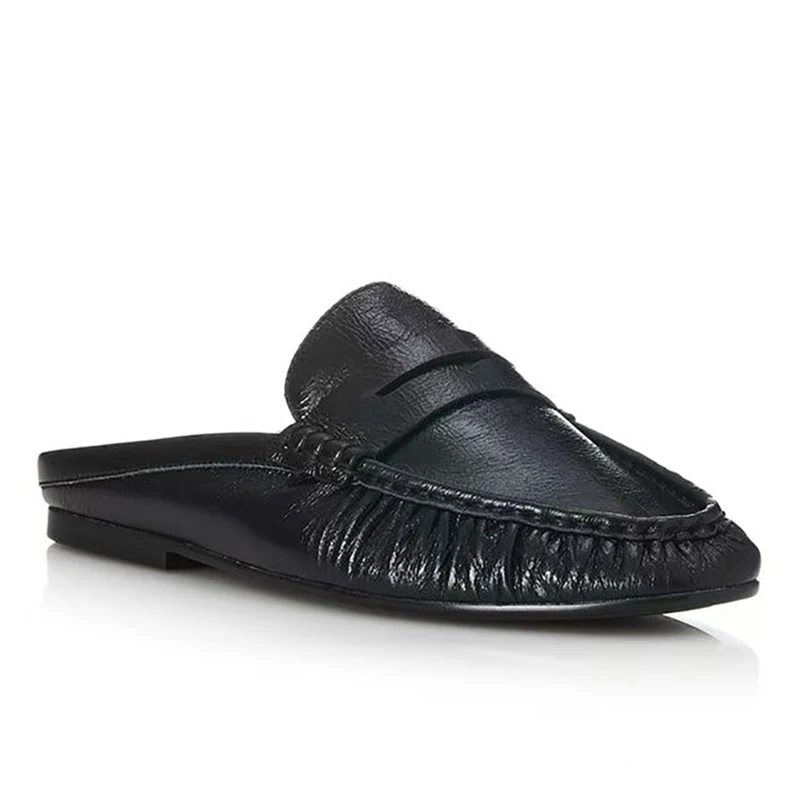
Selecting Foot-Friendly Wedge Loafers
Finding wedge loafers that truly support foot health requires attention to several key features:
Essential Features Checklist
Appropriate heel height: For daily wear, stay within 1-2 inches (2.5-5 cm) to minimize forefoot pressure and postural changes.
Adequate toe box space: Should be wide and high enough to wiggle toes freely. Test by standing and ensuring approximately 1/2 inch (1.3 cm) space beyond your longest toe.
Proper arch support: The footbed should contact your arch without creating pressure points. The level of support should match your foot’s natural arch height.
Quality cushioning: Press your thumb into the footbed—it should compress slightly and rebound quickly, indicating good shock absorption.
Stable base design: The bottom of the wedge should be wide enough to provide stability, with a slight flare at the edges for balance.
Material flexibility: The shoe should bend primarily at the ball of the foot, mimicking your foot’s natural flex point.
Secure fit: The heel shouldn’t slip, and the midfoot should feel securely held without tightness or pressure points.
Breathable materials: Look for natural materials like leather or suede, or synthetics specifically designed for air circulation.
Fit Testing Guidelines
When trying wedge loafers:
– Shop later in the day when feet are naturally at their largest
– Stand and walk on hard surfaces, not just carpeting
– Ensure both the length and width feel comfortable immediately
– Check for pressure points around the sides and top of the foot
– Make sure the arch support aligns with your natural arch position
– Test the shoe’s stability by standing on one foot
Remember that high-quality construction typically translates to better support features, so investing in well-made wedge loafers often pays dividends in comfort and foot health.
Women's Comfortable Flat Loafers, Women's Leopard Print Loafers, Women's Low Heel Loafers
$82.50 Select options This product has multiple variants. The options may be chosen on the product pageWomen's Block Heel Loafers, Women's Square Heel Loafers, Women's Square Toe Flat Loafers
Price range: $73.61 through $86.41 Select options This product has multiple variants. The options may be chosen on the product pageWomen's High Platform Loafers, Women's Wedge Heel Loafers
$171.07 Select options This product has multiple variants. The options may be chosen on the product pageWomen's Block Heel Loafers, Women's Leather Heeled Loafers, Women's Square Toe Flat Loafers
$109.84 Select options This product has multiple variants. The options may be chosen on the product pageWomen's Square Toe Flat Loafers
$143.64 Select options This product has multiple variants. The options may be chosen on the product pageWomen's Classic Tassel Loafers, Women's High Platform Loafers, Women's Suede Penny Loafers, Women's Wedge Heel Loafers
$119.77 Select options This product has multiple variants. The options may be chosen on the product page
The Benefits of Well-Designed Wedge Loafers
When thoughtfully designed with foot health in mind, wedge loafers offer several advantages over other elevated footwear styles:
Enhanced Stability
The continuous surface of a wedge provides significantly more stability than narrow or stiletto heels. This wider base of support reduces ankle wobble and improves balance, making wedge loafers a more secure option for walking and standing.
Better Weight Distribution
Compared to traditional high heels that concentrate pressure on a small heel area and the ball of the foot, wedge designs distribute weight more evenly across the sole. This distribution can reduce pressure points and improve comfort during wear.
Postural Advantages
The slope of a well-designed wedge creates less dramatic postural changes than an equivalent height stiletto heel. The continuous support under the arch can help maintain better alignment through the foot, potentially reducing strain on the knees and lower back.
Versatile Style Options
Wedge loafers bridge the gap between casual and formal styles, working well across various outfits and occasions. Their comfort advantages make them suitable for longer wear situations where traditional heels might become uncomfortable.
Potential Accommodation for Orthotics
Many wedge loafer styles offer removable footbeds that can accommodate custom orthotics or inserts, allowing for personalized support that’s difficult to achieve with many other heel styles.
For a deeper exploration of these benefits and how to maximize them, our article on why choose wedge heel loafers provides additional insights into making the most of this versatile footwear option.
Potential Drawbacks and Limitations
Despite their advantages over traditional heels, wedge loafers still present certain challenges for foot health that deserve consideration:
Increased Forefoot Pressure
Even the most supportive wedge design still shifts body weight forward, increasing pressure on the metatarsal heads (ball of the foot). This pressure can contribute to discomfort, calluses, or aggravate conditions like metatarsalgia with prolonged wear.
Limited Flexibility
Many wedge loafers feature relatively rigid construction that restricts the foot’s natural flexing motion during walking. This limitation can lead to altered gait patterns and potential muscle fatigue over time.
Muscle Adaptation Concerns
Regular wearing of elevated heels, including wedges, can lead to shortening of the calf muscles and Achilles tendon over time. This adaptation may reduce ankle flexibility and potentially contribute to discomfort when wearing flat shoes.
Weight Considerations
Wedge constructions are typically heavier than flats or even some traditional heeled shoes. This added weight can contribute to foot and leg fatigue during extended wear, especially in designs using dense materials like wood or thick rubber.
False Sense of Security
The improved stability of wedges compared to stilettos sometimes leads wearers to choose higher heights or wear them for longer periods than they should, potentially negating the biomechanical advantages.
Understanding these limitations helps set realistic expectations and informs better decisions about when and how long to wear wedge loafers for optimal foot health.
Smart Wearing Guidelines
To enjoy the style of wedge loafers while minimizing potential negative effects on foot health, follow these practical guidelines:
1. Limit Continuous Wearing Time
Even well-designed wedge loafers place extra stress on feet compared to flat shoes. For optimal foot health:
– Limit wedges over 2 inches (5 cm) to 3-4 hours of continuous wear
– Consider moderate height wedges (1-2 inches/2.5-5 cm) for regular workday wear
– Give feet recovery time between days of wearing elevated shoes
2. Practice Strategic Alternation
Rotate between different heel heights and shoe types throughout the week:
– Alternate wedge loafers with supportive flats
– Vary heel heights rather than wearing the same elevation daily
– Keep a pair of supportive backup shoes for when discomfort begins
3. Match the Shoe to the Activity
Choose wedge loafer heights appropriate for your planned activities:
– Low wedges (1 inch/2.5 cm) for moderate walking or standing
– Medium wedges (1.5-2 inches/3.5-5 cm) for office work with limited walking
– Reserve higher wedges for seated events or limited movement occasions
4. Recognize Warning Signs
Pay attention to your body’s signals that it’s time to change shoes:
– Numbness or tingling in the toes
– Persistent pressure spots or hot areas
– Pain in the ball of the foot or arch
– Lower back discomfort
– Developing blisters or redness
5. Implement Supportive Care
Complement your wedge loafer wear with foot-healthy practices:
– Stretch calf muscles and Achilles tendons daily
– Massage the plantar fascia with a tennis or massage ball
– Consider supportive inserts for added cushioning
– Elevate feet at the end of the day after wearing wedges
For more practical advice on integrating wedge loafers into your wardrobe while maintaining foot comfort, visit our guide to finding sole mate wedge heel loafers for personalized recommendations.
Are Wedge Loafers Right for Your Lifestyle?
The suitability of wedge loafers depends largely on your daily activities, existing foot conditions, and personal priorities. Consider these factors when determining their place in your footwear collection:
Workplace Considerations
Well-suited for: Office environments with limited walking, primarily seated positions, business casual dress codes
Less ideal for: Jobs requiring constant standing, extensive walking between locations, or formal conservative attire
Q: I stand at a retail counter for 8-hour shifts. Are wedge loafers appropriate?
A: For extended standing, choose only low wedges (1 inch/2.5 cm maximum) with excellent arch support and cushioning, or consider supportive flats instead.
Activity Level Assessment
Well-suited for: Short walks, social gatherings, dinner outings, light shopping
Less ideal for: City touring, all-day events requiring miles of walking, chasing after children
Q: I commute by public transit with a 15-minute walk each way. Can I wear wedge loafers?
A: Low to medium wedges with good support would be appropriate, but consider changing into them after arriving if your commute involves significant walking or standing.
Foot Condition Compatibility
May benefit: Mild plantar fasciitis (with proper arch support), slight heel pain (with cushioned design)
May aggravate: Bunions, hammertoes, metatarsalgia, balance issues, severe plantar fasciitis
Q: I have high arches and occasional heel pain. Would wedge loafers help or hurt?
A: Wedge loafers with substantial arch support and cushioning may actually provide better support than some flats, but they must be properly fitted to your specific arch profile.
For detailed guidance on incorporating wedge loafers into workplace attire, our article on how wear loafers office provides styling advice for various professional environments.
When to Choose Other Footwear Options
While wedge loafers can be a comfortable compromise between style and support, certain situations call for alternative footwear choices:
Physical Activities and Long Distances
Any activity involving sustained walking (over 30 minutes continuous), running, or athletic movement requires proper athletic shoes designed specifically for those movements. Wedge loafers restrict natural foot flexion and provide inadequate shock absorption for these activities.
During Pain or Inflammation
If you’re experiencing active foot pain, inflammation, or a flare-up of conditions like plantar fasciitis or Achilles tendonitis, it’s best to avoid any elevated heel until symptoms subside. Instead, choose footwear recommended by a podiatrist for your specific condition.
Unstable Surfaces or Weather Conditions
Wet, icy, or uneven surfaces present heightened fall risks with any elevated shoe. When navigating challenging terrain or inclement weather, prioritize footwear with flat, grippy soles and possibly ankle support.
Recovery Days
Even if you have comfortable wedge loafers, your feet benefit from regular breaks with zero-drop (completely flat) supportive shoes. Schedule “recovery days” in your footwear rotation to allow natural foot movement and muscle use.
Alternative Options for Different Needs
When wedge loafers aren’t appropriate, consider:
– Supportive flats with arch support and cushioning for all-day comfort
– Low block heels (under 1 inch/2.5 cm) for slight elevation with stability
– Oxford-style shoes with supportive footbeds for professional settings
– Athletic-inspired casual shoes for active days
FAQ: Common Questions About Wedge Loafers and Foot Health
Can wedge loafers help with back pain?
For some people, wedge loafers may reduce back pain compared to flat shoes or high stiletto heels. The moderate elevation can help those who find slight heel height alleviates back pressure, while the stability reduces muscle strain from balancing. However, this varies significantly between individuals—if back pain is a concern, consult a healthcare provider for personalized recommendations.
Are wedge loafers suitable for wide feet?
Many wedge loafer styles can accommodate wider feet, but this varies by brand and design. Look specifically for:
– Wide width options (marked W, D, or EE)
– Square or round toe boxes rather than pointed
– Soft, flexible upper materials that allow some stretch
– Adjustable features like buckles or elastic gores
Always try before buying, as width in the toe box is particularly important with wedge styles.
Do wedge loafers work with orthotics?
Some wedge loafers can accommodate custom orthotics, particularly those with:
– Removable insoles
– Deeper footbeds
– Adequate volume in the shoe
However, the elevated heel position may change how your orthotic functions. Consult your podiatrist about whether your specific orthotics are compatible with wedge heels.
How do I know if my wedge loafers fit properly?
Proper fit indicators include:
– No slipping at the heel when walking
– No pinching or pressure points around the sides
– Toes can wiggle freely and aren’t touching the end
– Width feels comfortable across the ball of the foot
– Arch support aligns with your foot’s arch
– No numbness or tingling after wearing for 15 minutes
Are wedge loafers better than traditional heels for foot health?
Wedge loafers typically offer better stability and weight distribution than similar-height traditional heels, potentially reducing ankle strain and improving balance. However, they still create forefoot pressure and posture changes. The best choice depends on the specific designs being compared and your individual foot structure and needs.

